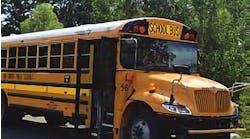Has it happened to you yet? Is it coming? For an increasing number of facilities and operations directors, the “it” is the need to take on the additional responsibilities of managing the transportation system at their local campuses. Tightening budgets have led many education institutions to reduce staffing by consolidating the positions of transportation and facilities director, regardless of experience and expertise. For individuals given this responsibility, the key is to develop an effective and simple system to ensure proper oversight of each operation.
Embracing the challenge
Facilities and transportation are capital-intensive operations with periods of high demand for building maintenance and route development. Both services are uncomplicated in their goals but complex in their operational requirements. Facilities managers are familiar with managing decentralized operations in which they must establish the goals of the program without being too rigid about how the goals are accomplished. This management characteristic is the most likely reason that administrators often consider these two positions as viable for consolidation.
When considering the consolidation of facilities and transportation management under one manager, it often is helpful to consider the responsibilities this new manager will have. Some of the major functions for which this manager is likely to oversee:
-
Custodial and grounds operations.
-
Facility maintenance and repairs.
-
Capital projects liaison or management.
-
Bus routing and scheduling.
-
Fleet maintenance and repair.
-
Personnel management.
-
Budgeting and financial management.
-
Materials management.
The performance of this individual will have an enormous effect on the institution's ability to provide a quality education to students. It is unlikely to be successful if the only purpose is to eliminate a position. To provide the best opportunity for success, it is imperative to structure the consolidated organization in a way that enables the director to focus on management of the operation rather than daily administration.
Given that the trend seems to be facilities managers taking over transportation, facilities personnel must realize that much of the hands-on attention they have provided in the past may be eliminated. If an informal communications system transmitted much of the operational knowledge, it must be replaced by a broad, structured approach. This can be accomplished by developing a rigorous performance-measurement and analysis program.
Managing consolidation
A manager who is given these dual responsibilities must answer the question, “If I didn't have enough time to manage my old job, how am I supposed to find the time to manage two jobs?” The use of a management-by-exception approach, in which a manager identifies areas of concern while monitoring aspects of the operation that are performing within expected guidelines, has been long adopted in the private sector and increasingly is being used by public entities of all types.
This performance-measurement approach is different from typical discussions of performance measurement, because it is focused on specific tactics that an operations director can use to manage both transportation and facilities programs. The goal is to establish a set of tactics that quickly identify existing or potential problems so that a plan can be developed to resolve the issues.
Using this type of approach, a manager would establish a series of norms or expectations for specific aspects of both facilities and transportation operations. These norms would be exception-oriented and would focus on the outputs of an organization (what it does) rather than the expected outcomes (what it hopes to accomplish).
After the norms are established, a system must capture the necessary data required to measure the response to specific events. Finally, a reporting system must be developed to ensure that managers receive feedback on the response to specific events in a timely manner so that abnormal events can be addressed quickly and appropriately.
Determining what measures to use often is the hardest part of establishing this type of program. The following is designed to provide a “running start” to developing a series of tactical performance measures that are appropriate for a specific operation:
- Facilities-management measures:
-
A backlog of work requests can identify which areas of the department may be understaffed or need more attention in prioritizing work.
-
The percentage of preventive maintenance accomplished may point out the need to analyze the deployment of resources for various maintenance functions. A commitment to preventive maintenance is essential to a well-run facilities operation.
-
Tracking utility usage against a baseline is vital. Identifying usage patterns outside norms can point to billing errors and possible leaks or malfunctions, in addition to providing opportunities to save the district substantial money from general energy management.
-
Custodial quality inspections are a way to assess the custodial-operations process and identify possible training deficiencies, or the need to redeploy staff for more effective outcomes.
-
- Transportation measures:
-
Off-schedule arrivals and departures show a potentially serious service issue that frustrates parents and building administrators.
-
Bus runs without drivers will indicate if more permanent substitute drivers need to be recruited or if the on-call driver list should be expanded. Consistent measurement also can determine whether the compensation system in place for bus drivers is appropriate.
-
Bus maintenance is a key fleet management indicator and a measure of service quality. Having a large percentage of the fleet regularly out of service also may be indicative of systemic problems.
-
Repair turnaround time should be compared to a standard for specific repair types. Coupling this report with the buses-out-of-service report can highlight problems in both maintenance and parts-management operations.
-
Anyone intending to use this type of system should apply the “Goldilock's principle.” This holds that it is not beneficial to use so many measures that managers are overwhelmed by detail, or so few measures that significant details are missed, but just the right number of measures so that all important aspects of the operation are receiving appropriate levels of attention. This balance typically is found through a trial-and-error approach that customizes the volume and type of measures to a specific operation.
The use of information systems is a key element in using this management approach. Acquiring fully integrated facility-maintenance, school bus-routing, fleet-maintenance and materials-management information certainly would be ideal, but also is unlikely.
In the absence of this nirvana, it is possible to use surrogate systems designed to capture specific pieces of data for use in later analysis. Using common productivity software, managers can develop data collection templates that will provide the necessary information to monitor and respond to changing conditions in all of their operations. After these systems are in place, a manager can establish a routine reporting schedule that can put out small fires before they become large infernos.
The scope and complexity of managing transportation and facilities can overwhelm someone who does not find a way to efficiently allocate time and attention. A targeted, tactical performance-measurement system that enables a manager to focus on addressing specific problems is one tool that will allow for a successful transition to a new consolidated position.
Ammon is a vice president of Management Partnership Services, Inc., Rockville, Md., a student transportation consulting company. Little is an associate executive director with the Michigan School Business Officials.
NOTABLE
4.9%
National median cost of transportation as a percentage of total school district expenditures.
Source: AS&U's 35th Annual M&O Cost Study, April 2006

